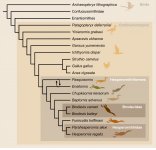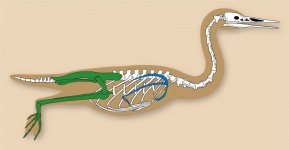albertonykus
Well-known member
Bell, A. and L.M. Chiappe (2022)
The Hesperornithiformes: a review of the diversity, distribution, and ecology of the earliest diving birds
Diversity 14: 267
doi: 10.3390/d14040267
The Hesperornithiformes (sometimes referred to as Hesperornithes) are the first known birds to have adapted to a fully aquatic lifestyle, appearing in the fossil record as flightless, foot-propelled divers in the early Late Cretaceous. Their known fossil record—broadly distributed across the Northern Hemisphere—shows a relatively rapid diversification into a wide range of body sizes and degrees of adaptation to the water, from the small Enaliornis and Pasquiaornis with lesser degrees of diving specialization to the large Hesperornis with extreme morphological specializations. Paleontologists have been studying these birds for over 150 years, dating back to the “Bone Wars” between Marsh and Cope, and as such have a long history of naming, and renaming, taxa. More recent work has focused to varying degrees on the evolutionary relationships, functional morphology, and histology of the group, but there are many opportunities remaining for better understanding these birds. Broad-scale taxonomic evaluations of the more than 20 known species, additional histological work, and the incorporation of digital visualization tools such as computed tomography scans can all add significantly to our understanding of these birds.
The Hesperornithiformes: a review of the diversity, distribution, and ecology of the earliest diving birds
Diversity 14: 267
doi: 10.3390/d14040267
The Hesperornithiformes (sometimes referred to as Hesperornithes) are the first known birds to have adapted to a fully aquatic lifestyle, appearing in the fossil record as flightless, foot-propelled divers in the early Late Cretaceous. Their known fossil record—broadly distributed across the Northern Hemisphere—shows a relatively rapid diversification into a wide range of body sizes and degrees of adaptation to the water, from the small Enaliornis and Pasquiaornis with lesser degrees of diving specialization to the large Hesperornis with extreme morphological specializations. Paleontologists have been studying these birds for over 150 years, dating back to the “Bone Wars” between Marsh and Cope, and as such have a long history of naming, and renaming, taxa. More recent work has focused to varying degrees on the evolutionary relationships, functional morphology, and histology of the group, but there are many opportunities remaining for better understanding these birds. Broad-scale taxonomic evaluations of the more than 20 known species, additional histological work, and the incorporation of digital visualization tools such as computed tomography scans can all add significantly to our understanding of these birds.






